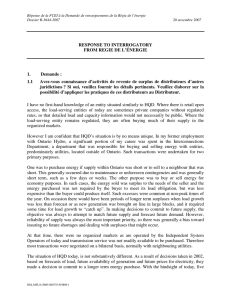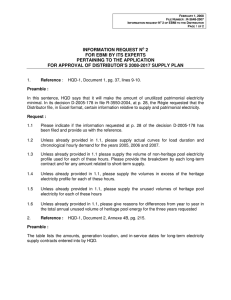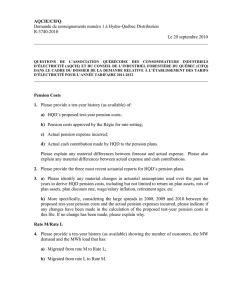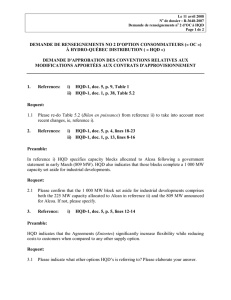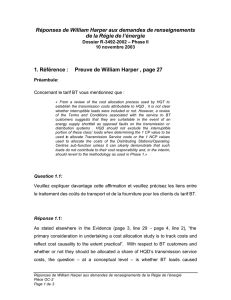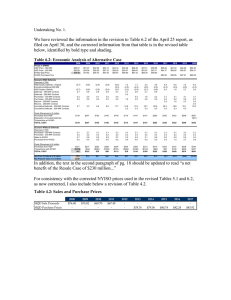RÉGIE DE L’ÉNERGIE HYDRO-QUÉBEC APPLICATION FOR APPROVAL OF THE
advertisement
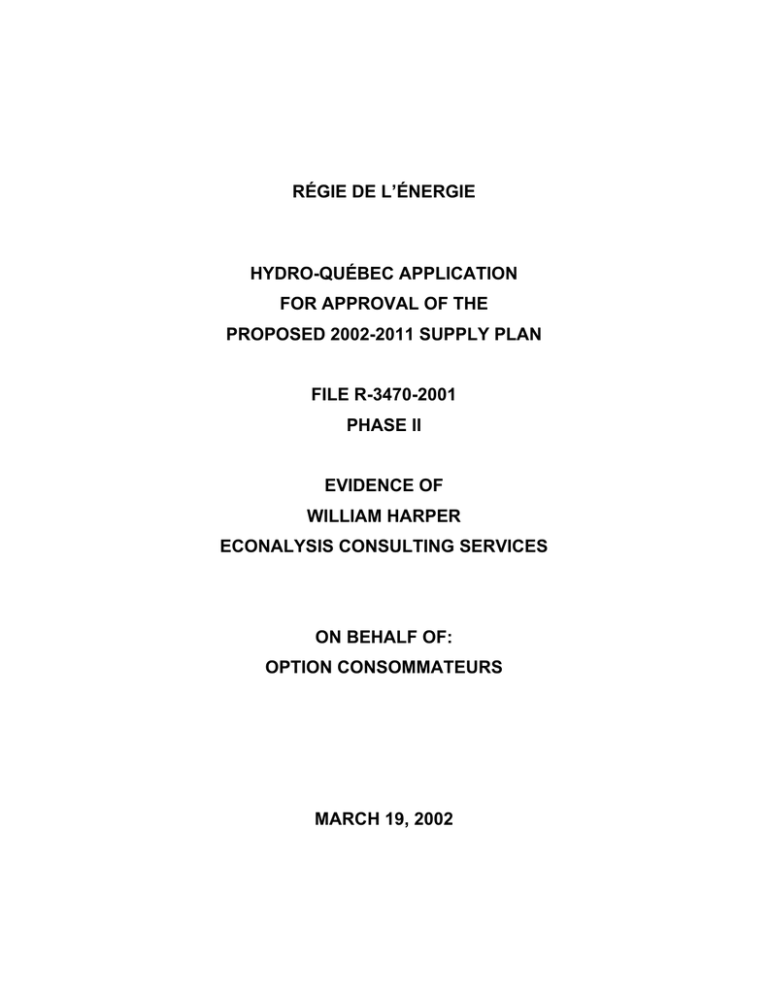
RÉGIE DE L’ÉNERGIE HYDRO-QUÉBEC APPLICATION FOR APPROVAL OF THE PROPOSED 2002-2011 SUPPLY PLAN FILE R-3470-2001 PHASE II EVIDENCE OF WILLIAM HARPER ECONALYSIS CONSULTING SERVICES ON BEHALF OF: OPTION CONSOMMATEURS MARCH 19, 2002 Table of Contents 1 2 3 4 1.0 Background ………………………………………………………….… 1 5 2.0 Purpose of Evidence ...……………………………………………….. 2 6 3.0 Summary of December 14th, 2001 Comments …………………… 3 7 3.1 Supply Planning for Hydro-Québec Distribution………….. 3 8 3.2 Specific Concerns …………………………..………………… 4 Additional Comments Regarding HQD’s Proposed Supply Plan 5 10 4.1 Avoided Costs …………………………………………………. 5 11 4.2 Load Forecast …………………………………………………. 6 12 4.3 Energy Efficiency ……………………………………………… 8 13 4.4 Pricing Options ………………………………………………... 10 14 4.5 Role and Dispatch of the Heritage Pool ..…………………. 12 15 4.6 Interties ……………………..…………………………………… 13 16 4.7 Reliability Criteria/Reserve Requirements ……………….. 14 17 4.8 Storage ………………………………………………………….. 18 Conclusions …………..……………………………………………….. 19 9 18 19 20 4.0 5.0 Evidence of William Harper 1 Hydro-Québec Distribution Régie File R-3470-2001 Phase II 1.0 Background 2 3 On October 25th, 2001, Hydro-Québec Distribution (HQD) filed an application 4 with the Régie de l’énergie requesting approval for its 2002-2011 electricity 5 supply plan and permission to launch a “call for tenders” process in January 2002 6 for 1,000 MW of supply for delivery commencing in 2006-2007. The Régie 7 subsequently issued an Order1 splitting the review of the Application into two 8 phases. The first Phase would deal with matters related to the proposed call for 9 tenders, while Phase II would deal with the overall supply plan. 10 11 Phase I took place during the fall of 2001 and early winter of 2002 and the Régie 12 issued its Decision on January 21, 20022. The Régie concluded that the demand 13 forecasts presented by HQD were reasonable3 and approved a call for tenders 14 for the 600 MW of incremental load projected for 2006 under the “average” load 15 forecast4. However, the Régie did not approve the inclusion of the additional 400 16 MW of dispatchable supply requested by HQD to address the possibility of higher 17 than anticipated loads in the future. The Régie indicated that it intended to re- 18 examine this question in Phase II of the proceeding. Other issues flagged by the 19 Régie for consideration in Phase II included: intertie limits/capacity, interruptible 20 power contracts, storage capabilities, short term power supply available inside 21 Québec, load forecast uncertainty and HQD’s avoided cost methodology5. 22 23 The Régie accepted HQD’s proposal to limit participation in the first call for 24 tenders to suppliers inside Québec and those outside Québec that would not 25 utilize existing or currently planned interconnections. It also concluded that it 26 was premature to consider the participation of energy service companies6. 1 D-2001-254 / R-3470-2001 D-2002-17 / R-3470-2001 3 D-2002-17, page 16 4 D-2002-17, page 23 5 D-2002-17, pages 15, 16 and 23. 6 D-2002-17, page 24 2 1 Evidence of William Harper Hydro-Québec Distribution Régie File R-3470-2001 Phase II 1 2 On January 7th, 2002, the Régie issued a procedural order7 initiating Phase II of 3 its review of HQD’s proposed 2002-2011 Supply Plan. 4 5 6 2.0 Purpose of Evidence 7 8 I was retained by Option Consommateurs (OC) during Phase I to provide 9 comments on issues associated with HQD’s request for authorization to issue a 10 call for tenders in January 2002 for 1,000 MW of base and dispatchable capacity 11 for delivery in 2006/2007. In order to assess the reasonableness of HQD’s call 12 for tenders proposal it was necessary to review the supply planning process 13 underlying the development of the proposal. As a result, the Comments 14 prepared for Phase I8 addressed a number of issues that are also relevant to 15 Phase II of the proceeding. 16 17 For Phase II of the proceeding, OC has requested that I review the additional 18 materials provided by HQD and update my December 14th, 2001 Comments as 19 they apply to HQD’s overall 2002-2011 proposed Supply Plan. My qualifications 20 and CV are included as part of the Phase I Comments9. 21 22 The Phase II Evidence starts with a summary of the December 14th, 2001 23 Comments, as they pertain to HQD’s supply planning process and proposed 24 Supply Plan. This is followed by more detailed comments based on the 25 additional information provided during Phase II. 26 27 7 D-2002-01 / R-3470-2001 Comments Prepared by William Harper on Behalf of Option Consommateurs, December 14, 2001 9 Pages 3-4 and Appendix A. 8 2 Evidence of William Harper 1 Hydro-Québec Distribution Régie File R-3470-2001 Phase II 3.0 Summary of December 14th, 2001 Comments 2 3 3.1 Supply Planning for Hydro-Québec Distribution 4 5 The Comments noted that HQD’s supply planning needed to be adapted to meet 6 the statutory requirement for a “call for tenders” process to identify and select 7 supply side options. However, they concluded that this could (and should) be 8 done within the context of an overall supply planning process that consisted of 9 the following elements: 10 o A clear set of planning goals/objectives that provide a consistent basis for 11 establishing reliability criteria/reserve margins, evaluation criteria for 12 assessing alternatives and selection criteria for evaluating alternative 13 supply “bids” ultimately received in response to the Company’s call for 14 tenders; 15 o A credible load forecast that provides insight into the uncertainty 16 attributable to future electricity demand and transparently captures the 17 implications of various demand side management initiatives; 18 o A transparent reserve margin target, where both the basis for the reserve 19 margin target and the “risks” it is meant to address are clearly articulated; 20 o A comprehensive identification and assessment of all alternatives. All 21 potential options for meeting future load requirements need to be identified 22 and fairly evaluated on an integrated basis using a standard set of 23 economic criteria; 24 25 26 o An explicit assessment of the risks associated with any proposed plan; and, o The recognition that planning is not a linear process and certain 27 iterations/feedbacks may be necessary. For example, if the evaluation of 28 alternative supply options suggests that the price of electricity will have to 29 increase this would need to be factored back into the load forecast. 30 31 3 Evidence of William Harper 1 Hydro-Québec Distribution Régie File R-3470-2001 Phase II 3.2 Specific Concerns 2 3 A number of areas of concern were identified during Phase I Comments 4 regarding HQD’s overall proposed supply plan, including: 5 6 The Avoided Costs Used, and the fact that they are based on average and 7 not incremental costs; 8 The Load Forecast, in terms of its transparency, a potential bias in the 9 forecast results and the uncertainty incorporated into the various planning 10 scenarios used; 11 Future Energy Efficiency Gains, in terms of the need to integrate HQD’s new 12 Energy Efficiency Plan into the supply planning process and ensure that the 13 Plan reflects the avoided costs associated with incremental supply; 14 Pricing Options, in terms of the need to consider and integrate new pricing 15 options (such as interruptible power) into the supply planning process; 16 The Role of the Heritage Pool, in terms of how it will be dispatched and 17 utilized in the future and the impact on need for additional supplies; 18 Role of the Interties, in terms of HQD’s proposal to limit its reliance on 19 existing and currently planned interconnections for 5 TWh per annum to meet 20 load forecast uncertainty associated with variations in weather; and, 21 The Reliability Criteria Used/Reserves Required, in terms of the need for a 22 more comprehensive discussion of the reliability criteria used, the total 23 reserves required from all sources and the risks involved. 24 25 These are each reviewed in more detail in the following section, along with the 26 issue of storage that was raised in D-2002-17. 27 28 29 4 Evidence of William Harper 1 Hydro-Québec Distribution Régie File R-3470-2001 Phase II 4.0 Additional Comments Regarding HQD’s Proposed Supply Plan 2 3 4.1 Avoided Costs 4 5 The Phase I Comments concluded that avoided costs used for purposes of 6 evaluating energy efficiency initiatives (and other non-supply based initiatives) 7 after 2005 should reflect the cost of new supply – rather than the average cost of 8 supply from the Heritage Pool and new supplies. In D-2002-17 the Régie 9 concurred and directed10 HQD to revise its methodology for Phase II. 10 11 In response to a Régie interrogatory11, HQD has indicated that it considers 5.5 12 cents/kWh – which reflects the cost of electricity from a (generic) combined cycle 13 combustion gas turbine – to be a reasonable estimate of the marginal cost of 14 electricity production and transmission, once load exceeds the Heritage Pool 15 supply. In the same response, HQD indicates that the avoided costs it employs 16 for distribution are consistent with the costs presented in R-3453-2000. HQD has 17 also indicated that the reference R-3473-2001 will look at the impact of variations 18 in avoided costs on the technical/economic potential for energy efficiency 19 improvements. 20 21 The proper determination of avoided costs is critical to ensuring that the supply 22 planning process results in the least cost combination of energy efficiency (and 23 pricing) options and new supply side options. Despite the interest expressed by 24 the Régie in considering HQD’s avoided cost methodology in Phase II, there is 25 insufficient information on the record at this time to reach any conclusions 26 regarding HQD’s approach to determining avoided costs and the reasonableness 27 of the proposed values12. Furthermore, the current proceeding may not be the 10 D-2002-17, R-3470-2001, pages 15-16. HQD-6, Document 1, pages 17-18, interrogatory 7.1. 12 What is required is information clearly setting out the avoided costs HQD proposes to use for production, transmission and distribution (along with how they were determined and the underlying assumptions) as 11 5 Evidence of William Harper Hydro-Québec Distribution Régie File R-3470-2001 Phase II 1 best venue for addressing this issue. Another approach would be for the Régie 2 to direct HQD to include the determination of avoided costs as one of the issues 3 for consideration in R-3473-2001. 4 5 The consultative process underlying R-3473-2001 has just commenced13 and, as 6 a result, it is likely that the proceeding will not be completed until after the Régie- 7 approved call for tenders process has been completed on the supply side. One 8 of the benefits of this timing is that avoided cost methodology can be refined to 9 reflect the actual cost of new supplies as determined through the current 10 tendering process and the revised values used to develop projections for both 11 the technical/economic potential for energy efficiency improvements and 12 standards as well as actual program expectations. Within the same process, 13 HQD could review with parties its methodology for determining the avoided costs 14 for transmission and distribution and provide documentation of the same as part 15 of its Application. 16 17 This approach would allow parties to develop an understanding of the 18 methodology and ask questions within the more informal working of the 19 consultative process. It would also allow any fundamental differences to be 20 addressed by the Régie. In addition, the sensitivity analyses that are part of R- 21 3473-2001 will allow parties to determine whether any differences in view as to 22 avoided costs have a material impact on the opportunities for energy efficiency. 23 24 4.2 Load Forecast 25 26 The Phase I Comments concluded that HQD could improve the credibility of its 27 load forecast by providing further information regarding its forecasting 28 methodologies. The Comments also expressed concerns regarding an apparent well as how they are translated into avoided costs for the various customer classes. While HQD did provide some information in response to Phase II interrogatories, the materials need to be explored further. 13 Consultative meetings are currently scheduled to continue through to June 2002. 6 Evidence of William Harper Hydro-Québec Distribution Régie File R-3470-2001 Phase II 1 bias in the long term forecasting results and suggested that HQD should provide 2 stakeholders with a better understanding of the risks and uncertainty associated 3 with its various load growth scenarios. 4 5 Load Forecasting Methodology 6 7 In responding to Phase II interrogatories, HQD has provided considerably more 8 detail regarding its load forecasting methodology14. The information provided is 9 still at a fairly “high level”, but it does provide parties with a better understanding 10 of the approach used by HQD and assurance that changes in 11 demographic/economic outlook and energy prices are captured in a logical and 12 structured manner. While further details would serve to enhance parties’ 13 understanding and acceptance of the HQD’s load forecasts, neither the time nor 14 the resources available in current proceeding are sufficient for a more detailed 15 review. 16 17 It would be useful if, as part of the R-3473-2001 process, HQD were to review 18 with participants how its load forecasting methodology incorporates energy 19 efficiency improvements and standards. 20 21 Load Forecast Bias 22 23 In response to a Régie interrogatory15, HQD claims that the fact its forecasts 24 were consistently too low during the 1980’s and too high during the 1990’s 25 demonstrates that their load forecasting methodology is unbiased. However, it is 26 precisely these results that gave rise to the concern in the first place. The reason 27 for the consistent over-forecasting throughout the 1990’s continues to be 28 unexplained. 29 14 15 For instance, HQD-6, Document 7, pages 5-12, interrogatory 2 and Annexe 1. HQD-6, Document 1, pages 5-6, interrogatory 3.1 7 Evidence of William Harper 1 Hydro-Québec Distribution Régie File R-3470-2001 Phase II Load Forecast Uncertainty 2 3 HQD has provided16 additional information regarding the risk associated with its 4 load forecast and the range of uncertainty captured by it various load forecast 5 scenarios. This information indicates that the band of potential future load 6 requirements represented by the weak to strong scenarios has an 80% 7 probability of capturing the actual future loads, prior to any consideration of 8 variation due to weather17. This suggests a much higher risk that loads in excess 9 of the strong scenario will occur than what was reflected in the Phase I 10 Comments, when it appeared that there was very low probability of both the mid- 11 strong and strong scenarios occurring18. The implications of this are reflected in 12 the Section 4.7 comments regarding reserve requirements. 13 14 4.3 Energy Efficiency 15 16 The Phase I Comments concluded that expectations regarding future energy 17 efficiency improvement based on the avoided cost of new supply should be 18 integrated into HQD’s supply plan and that, ideally, the MWs of new supply 19 required to be contracted for through the current call for tenders process should 20 be updated prior to the actual selection of successful bidders. 21 22 In response to Phase II interrogatories from various parties19, HQD has indicated 23 that revisions to the technical/economic potential for energy efficiency programs 24 and standards and the program results that can be expected in future years are 25 matters that will be dealt with in R-3473-2001. Given the current status of this 26 proceeding20, it is unlikely that the findings and any determinations by the Régie 16 HQD-6, Document 1, pages 8-14, interrogatory 4; Document 2, pages 4-5, interrogatories 2-4 & 2-5 and Document 7, page 14, interrogatory 4. 17 HQD-6, Document 1, page 13. 18 Comments prepared by Bill Harper on Behalf of Option Consommateurs, December 14, 2001, page 30. 19 Régie IR 7.2; ACÉÉ-SÉ-GS IRs 2.12, 2.14 & 2.22 to 2.34 (inclusive) and OC IR 8 20 Stakeholder meetings are expected to continue until June 2002 after which HQD will prepare an Application for consideration by the Régie. 8 Evidence of William Harper Hydro-Québec Distribution Régie File R-3470-2001 Phase II 1 will be available until the end of this year. This is too late for the results to be 2 incorporated into the decisions as to the MWs of supply to be contracted for as a 3 result of the current tendering process. However, given the decision of the Régie 4 to limit the current tendering process to 600 MW (as opposed to the 1,000 MW 5 originally requested by HQD), it is not as crucial that the results be available for 6 this purpose. 7 8 It is important that the findings from R-3473-2001 be incorporated into HQD’s 9 overall supply requirements and the “call for tenders” that the Company issues as 10 soon as possible (i.e., the June 2003 call for tenders). In order to ensure that this 11 occurs, any decisions that the Régie makes regarding HQD’s current proposed 12 supply plan should be “interim” and only “finalized” once the results of R-3473- 13 2001 have been satisfactorily integrated into the plan. 14 15 To do otherwise would mean that the findings from R-3473-2001 would not be 16 reflected in HQD’s planning process until it prepared its next supply plan in 2004 17 and would not impact the tendering process until calls were made for supply for 18 2010/201121. 19 20 Another concern with the R-3473-2001 process is HQD’s view that the energy 21 efficiency plan developed as a result of the process will only cover 3 years – 22 2003-200622. While it is reasonable that this be the case from a detailed 23 programming perspective, it is important that the process also develop longer 24 term projections as to both the technical/economic potential for future energy 25 efficiency improvements and what could reasonably be expected to be achieved 26 through actual programs and standards. The Régie should make it clear that the 27 preparation of such long-term projections is part of the requirements associated 28 with R-3473-2001. Otherwise, HQD will never be in a position to properly 21 Assuming one call for tenders per year in June as proposed by HQD in HQD-2, Document 3, page 30, lines 6-8 and a 66 month lead time. 22 HQD-6, Document 2, page 17, interrogatory 2-34. 9 Evidence of William Harper Hydro-Québec Distribution Régie File R-3470-2001 Phase II 1 incorporate energy efficiency improvements into its supply planning and 2 tendering processes. 3 4 4.4 Pricing Options 5 6 The Phase I Comments observed that interruptible power could provide a cost- 7 effective alternative to new supply side capacity options. As a result, 8 consideration must be given to the development of interruptible pricing programs 9 based on the avoided cost of new supply and the impact incorporated into HQD’s 10 supply plan. 11 12 In response to various Phase II interrogatories, HQD has further clarified its view 13 as to the role of interruptible power in meeting future load requirements. 14 Specifically, HQD considers interruptible power as a useful tool in managing 15 variations in load due to changes in weather conditions23. In this regard it is 16 viewed as comparable to short term purchases. However, HQD does not see 17 any role for interruptible power over the current planning horizon as part of it 18 supply plan for meeting projected load requirements in excess of the Heritage 19 Pool under various load growth scenarios24. Also, HQD seems to have altered 20 its commitment to a new interruptible pricing program indicating that it will 21 propose an acquisition strategy for interruptible power when the need arises25. 22 23 This mixed message with respect to the need for interruptible power arises as a 24 result of HQD’s failure to consider and incorporate all of its reserve requirements 25 together as part of its overall supply plan. Instead, as discussed in Section 4.7, 26 the need for reserves to meet load variations due to weather conditions are 27 determined and addressed separately. 28 23 HQD-6, Document 5, page 17, interrogatory 10. HQD-6, Document 1, page 45, interrogatory 23.1; HQD-6, Document 5, page 17, interrogatory 10 and HQD-6, Document 4, page 24, interrogatory 13.5 25 HQD-6, Document 3, page 14, interrogatory 6-C. 24 10 Evidence of William Harper Hydro-Québec Distribution Régie File R-3470-2001 Phase II 1 It is clear, even from HQD’s evidence, that interruptible power can play a useful 2 role in meeting future load requirements over the current 2002-2011 planning 3 horizon. In addition, once in place the capacity available to HQD through 4 interruptible power could also be used to maintain operating reserves for short 5 periods of time and to help manage short-term differences between the day- 6 ahead load forecast (used to establish the initial dispatch of the Heritage Pool 7 and new supply options) and actual loads that can not be addressed by revising 8 the Heritage Pool dispatch (see Section 4.5). 9 10 The Régie should encourage HQD to proceed with the development and 11 submission for approval of a new interruptible pricing program such that the 12 program can be in place prior to 2004. This will allow HQD to incorporate the 13 anticipated results of the program into its next supply plan. 14 15 Other pricing related options are available to HQD to help manage incremental 16 load requirements. HQD’s load forecast assumes that the impact of the current 17 residential dual-energy program remains constant at 880 MW over the planning 18 horizon. However, during this same period the number of residential electric 19 heating customers is expected to grow by 28,000 households per year or 1.2% 20 per annum26. If appropriate programs were introduced by HQD to ensure that a 21 portion of these households participated in the dual-energy program (equivalent 22 to the proportion of total households currently participating in the program) then 23 peak demand in 2011 could be reduced by roughly 100 MWs27. HQD should be 24 encouraged to identify and pursue such opportunities where cost-effective. 25 26 26 HQD-6, Document 7, page 16, interrogatory 6.1. The value is ‘rough’ as it will be impacted by the adoption of other efficiency measures, etc. The key point is that other opportunities exist that could have a material impact. 27 11 Evidence of William Harper 1 Hydro-Québec Distribution Régie File R-3470-2001 Phase II 4.5 Role and Dispatch of the Heritage Pool 2 3 The Phase I Comments observed that further clarity was required as to how the 4 Heritage Pool supplies would be dispatched on a day-to-day basis in order that 5 new suppliers would be able to understand how they would be expected to 6 operate. 7 8 Through its Phase II interrogatory responses28, HQD has provided more details 9 as to how the supplies available from the Heritage Pool will be managed by HQD 10 and dispatch decisions made to meet daily load requirements. In explaining how 11 the Heritage Pool will be managed, HQD has characterized the supply as being 12 equivalent to 8,760 “options” which can be exercised throughout a 12-month 13 period29. 14 15 While this analogy helps, there still appears to be some inconsistencies in the 16 explanation as to how the actual Heritage Pool usage will be determined for each 17 day and the risks to HQD given that the actual load for the full 12 months is not 18 known at the time of dispatch: 19 In response to AQCIE-AIFQ interrogatory 3-E30, HQD indicates that if the 20 actual load differs from the dispatch forecast, then it is the actual load that 21 will determine the Heritage Pool supply. However, clearly this matching 22 can only occur through a reselection from the remaining “options”. To the 23 extent that none of the remaining (unexercised) options allow the actual 24 load to be matched precisely, the Heritage Pool supply can not pick up all 25 of the variation between the dispatch forecast and the actual load and new 26 supplies must be called upon to do so. Furthermore, the lack of perfect 27 foresight in terms of future loads is likely to lead to less than optimal 28 dispatch of the Heritage Pool. 28 HQD-6, Document 3, pages 6-12, interrogatories 2 through 5 and Document 7, pages 21-24, interrogatory 9. 29 HQD-6, Document 3, page 10, interrogatory 4-I. 30 HQD-6, Document 3, page 8 12 Evidence of William Harper Hydro-Québec Distribution Régie File R-3470-2001 Phase II 1 However, when the question of whether this would impact on the ability of 2 the HQD to optimize the dispatch of the Heritage Pool was raised31, the 3 Company denied that there was an issue. 4 5 As a result, there continues to be a need for clarification as to exactly how the 6 Heritage Pool supply will be utilized. This issue has implications not only for new 7 suppliers (as suggested in the Phase I Comments) but also for HQD in terms of 8 the uncertainty it must manage and, therefore, the supplies it must contract for. 9 10 4.6 Interties 11 12 The Phase I Comments raised a couple of issues with respect to how HQD 13 incorporated interties into its supply plan. The first was a concern that HQD had 14 summarily discounted the generation that could be available based on its view of 15 “market conditions” as opposed to testing this view through the call for tenders 16 process. The second concern was that HQD had arbitrarily determined that the 5 17 TWh it did deem to be available through the interties should be reserved for 18 short-term purchases to address uncertainty in future loads due to weather 19 variations. 20 21 In its response to various Phase II interrogatories32, HQD clarified that: o 34.7 TWh represented the technical/physical limit as to the amount of 22 additional power that could be imported over existing/planned interties; 23 o 20 TWh represented the amount of power that was available to import 24 25 over the interties after taking into account the market considerations such 26 as capacity requirements and generation availability in neighbouring 27 jurisdictions; 31 32 HQD-6, Document 7, pages 22-23, interrogatories 9.2 iv) and 9.3 i-iii) HQD-6, Document 7, pages 34-35, interrogatory 21.1. 13 Evidence of William Harper Hydro-Québec Distribution Régie File R-3470-2001 Phase II o 10 TWh represented the portion of the 20 TWh that was of value to HQD, 1 2 given that a significant portion of the 20 TWh was available in the off-peak 3 period; and o 5 TWh represented the strategic limit adopted by HQD for planning 4 purposes based on 50% of the 10 TWh. 5 6 The application of market considerations reduces the potential import limit in the 7 peak period by roughly 10 TWh (i.e., from 15.6 TWh to 5 TWh33). Such 8 considerations may have been appropriate prior to market restructuring/open 9 access when utilities essentially constructed all of the generation capacity and 10 exported power surplus to their needs. However, contrary to HQD’s claims34, it is 11 not appropriate in today’s or tomorrow’s emerging market place. To the extent 12 that there are no transmission limitations in neighbouring systems, extra- 13 provincial utilities or other providers of generation are free to enter into longer- 14 term firm supply contracts with HQD that would utilize some or all of the available 15 10 TWh of import capacity and the security of the power would be the same as 16 for that contracted for from sources inside Québec. 17 18 As noted in the Phase I Comments, the only way to determine if such 19 opportunities exist is to allow participation in the tendering process by parties 20 outside Québec, even if the proposals involve the use of existing/planned 21 interties. In order to maintain the 5 TWh short-term import capability (for both 22 itself and Hydro-Québec Production), HQD could limit participation to 10 TWh in 23 the peak period (i.e., the reduction associated with market constraints). 24 25 4.7 Reliability Criteria/Reserve Requirements 26 27 The Phase I Comments expressed concern that the reliability and reserve 28 requirements were not addressed in a comprehensive manner, but rather 29 requirements to manage variations in load due to weather were dealt with 33 34 HQD-4, Document 1, page 30, interrogatory 17.1. HQD-6, Document 1, page 26, interrogatories 12.1 & 12.2. 14 Evidence of William Harper Hydro-Québec Distribution Régie File R-3470-2001 Phase II 1 separately from the reserves required to deal with load forecast uncertainty35 and 2 non-availability of supply from contracted incremental sources. Concern was 3 also expressed regarding the lack of rationale to support the proposed 400 MW 4 of planned reserve. Finally, while there was limited information available as to 5 the risks/uncertainties involved, the Comments concluded that the 1,000 MWs 6 proposed for additional supply in 2006/2007 appeared sufficient to cover all but 7 the most improbable load forecast. 8 9 Responses to Phase II interrogatories36 have confirmed that the primary purpose 10 of the proposed 400MW reserve is to address load forecast uncertainty and non- 11 availability of incremental supplies, as opposed to the NPCC requirement that 12 load not exceed supply more than once every 10 years (or 2.4 hours per year). 13 However, the responses failed to provide any further insight into why 400 MWs 14 was the appropriate level of reserve. 15 16 According to HQD37, the proposed strategy allows the Company to meet the 17 strong scenario set out in the initial Application. This would suggest, based on 18 responses to the Régie interrogatories38, that there is roughly a 10% chance that 19 load would exceed the currently planned level of supply39. However a closer look 20 at the details would suggest that the risk is somewhat higher. The following table 21 sets out the available supplies based on HQD’s strategy and contrasts them with 22 the projected load levels under the various scenarios developed by HQD. 23 35 Due to changes in demographic/economic conditions or energy prices HQD-6, Document 1, pages 37-40, interrogatory 20.1. 37 HQD-6, Document 7, page 31, interrogatory 17.2. 38 HQD-6, Document 1, page 13, interrogatory 4.2. 39 Separate and apart from any consideration of variation in load as a result of weather. 36 15 Evidence of William Harper Hydro-Québec Distribution Régie File R-3470-2001 Phase II 1 2007 2008 2009 Supply: - Proposed 1000 MW/7.3 TWh 1280 MW/9.3 TWh 1430MW/10.4 TWh 1410 MW/8.9 TWh 1410 MW/8.9 TWh 1410 MW/8.9 TWh 2410 MW/16.2 TWh 2690MW/18.2 TWh 2840 MW/19.3 TWh 600MW/4.1 TWh 880MW/6.4 TWh 1030MW/7.5 TWh 1670MW/11.5 TWh 2160MW/14.8 TWh 2620MW/16.6 TWh 3040MW/18.8 TWh 3720MW/23.2 TWh 4360MW/25.8 TWh SupplySide Options40 - Available Short Term Supply41 Total Incremental Demand42 - Average - MidStrong - Strong 2 3 Based on existing plans and HQD’s expectation as to the supplies available 4 through short-term purchases, it appears that the resource available to HQD 5 have the capability to meet future load levels somewhere between the mid-strong 6 and strong scenarios. The associated probability of load outstripping supply is in 7 the order of 15%43. 8 40 HQD-2, Document 3, page 28 HQD-6, Document 7, page 31, interrogatory 17.3. 42 HQD-2, Document 3, pages 8-9. 43 The probabilities reported by HQD in response to OC Phase II interrogatory 4.2 are consistent with a normal probability distribution. The 15% is derived using the average and standard deviations reported in HQD-6, Document 1, interrogatory 4.2 and does not make any allowance for operating reserves. 41 16 Evidence of William Harper Hydro-Québec Distribution Régie File R-3470-2001 Phase II 1 Whether 10% or 15%, the level of risk now understood to be associated with the 2 proposed strategy is higher that that reflected in the Phase I Comments. In fact, 3 taken at face value, it would appear that there’s need for caution (if not concern) 4 with the risks inherent in the supply plan as proposed. However, there are a 5 number of factors that may tend to mitigate this risk: o Higher load levels do not materialize overnight and HQD has indicated44 6 7 that if faced with evidence of higher load growth it would be able to 8 contract for additional resources on a shorter timeframe; o The load forecast is likely to be adjusted downwards as a result of R- 9 3473-2001; 10 o Precisely how much HQD can count on from short term purchases will not 11 12 be fully understood until the current RFP process has been completed45; 13 and, o There are opportunities to further reduce load requirements through 14 15 pricing options such as interruptible power, which are not reflected in the 16 current plan. 17 18 The earlier comments regarding energy efficiency concluded that the Régie 19 should make any approval of HQD’s proposed supply plan “interim” pending 20 completion of R-3473-2001 and incorporation of the findings into the current 21 supply plan. Given the above risk assessment, the need for such an update 22 takes on increased importance. At the same time, HQD should be required, as 23 part of any “interim” order, to update its Supply Plan and expected capabilities to 24 reflect the results of its call for tenders for short term supplies46. 25 26 The Québec Government Bylaw regarding the Supply Plan requires HQD to 27 provide demand and supply information for the next 10 years47. However, HQD 28 has only provided its supply strategy through to 2009 and declined to provide 44 HQD-6, Document 7, page 30, interrogatory 17.1. HQD-6, Document 7, page 31, interrogatory 17.3. 46 HQD-2, Document 3, pages 30 to 33. 47 Règlement sur la teneur et la périodicité du plan d’approvisionnement, (2001) 133 G.O. II, 6038. 45 17 Evidence of William Harper Hydro-Québec Distribution Régie File R-3470-2001 Phase II 1 data for 2010 and 201148. While details as to the types of capacity that would be 2 included in calls for tender for the year 2010 and 2011 are not necessary at this 3 time, provision of the overall projected supply needs for those years would, at a 4 minimum, help put the plans for 2003-2009 into context. 5 6 Finally, the NPCC requirements do start to play an increasing role towards the 7 end of the period. The 15% reserve margin used to determine the incremental 8 supplies associated with this requirement is contingent upon the size, types and 9 diversity of supplies contracted for by HQD. It will be important that HQD bear 10 this in mind as it selects the successful “bidders” from its current and future 11 tendering processes. Undue reliance on one supplier, supply source or type of 12 supply could increase this reserve margin and increase the overall cost of supply. 13 14 4.8 Storage 15 16 In its Phase I Decision the Régie raised the issue of storage49 as did a number of 17 parties in their Phase II interrogatories. Hydro Québec has indicated that while 18 access to hydraulic storage represents an interesting opportunity for the 19 Company, it cannot fully replace the need for new supplies, as it does not 20 represent an increase in energy supply50. 21 22 However, access to hydraulic storage would give HQD another tool for managing 23 any differences (both positive and negative) between the day-ahead load 24 forecast (used to establish the initial dispatch of the Heritage Pool and new 25 supply options) and actual loads that can not be addressed by revising the 26 Heritage Pool Dispatch (see Section 4.5). Such an approach could not only 27 reduce HQD’s requirements for new supply for alternatives but also reduce the 28 uncertainty associated with the expected operation of any new supply options 48 HQD-6, Document 1, page 35, interrogatory 19.1 and HQD-6, Document 7, page 40, interrogatory 25.1. D-2002-17, R-3470-2001, page 23. 50 HQD-6, Document 3, page 3, interrogatory 1-B and HQD-6, Document 1, pages 42-43, interrogatory 22.1. 49 18 Evidence of William Harper Hydro-Québec Distribution Régie File R-3470-2001 Phase II 1 that are contracted for. The Régie should encourage HQD to pursue such 2 alternatives with Hydro-Québec Production and also encourage the Government 3 of Québec to remove any barriers51 that may exist to other parties developing 4 hydraulic facilities with storage capability. 5 6 5.0 Conclusions 7 8 The Phase I Comments concluded that HQD should be directed to update its 9 Supply Plan prior to the approval of any specific supply contracts and that the 10 updated plan should include: o A clear definition of the reliability and costing criteria used in the planning 11 process; 12 13 o A revised load forecast that reflects the anticipated impacts of energy 14 efficiency programs and interruptible rate programs based on avoided 15 costs consistent with the cost of new supplies; and o A comprehensive assessment of reserve requirements, including short- 16 term purchases. 17 18 19 The need for an updated Supply Plan still exists. However, given the timing of 20 the R-3473-2001 process, it is recommended that: 21 1. The Régie should direct HQD to include, as part of the scope of R-3473- 22 2001 the determination of avoided costs and the methodology used to 23 incorporate energy efficiency into its load forecast. 2. The Régie should grant interim approval to HQD’s proposed supply plan 24 and indicate that final approval is contingent upon HQD updating the plan: 25 26 a. To reflect the results of R-3473-2001, 27 b. To clarify the resulting risks of future load requirements exceeding supply during the planning period, and 28 51 It is my understanding that the Crown Corporation Hydro Québec holds a legal monopoly over the construction and operation of over 50 MW hydraulic plants. 19 Evidence of William Harper 1 2 3 4 5 6 Hydro-Québec Distribution Régie File R-3470-2001 Phase II c. To indicate the alternatives that are available to meet such contingencies (e.g. additional supplies and interruptible power). 3. The Régie should encourage HQD to develop and submit for approval an interruptible pricing program for introduction no later than 2004. 4. The Régie should encourage HQD to pursue other pricing options aimed at managing future incremental load requirements. 7 20
